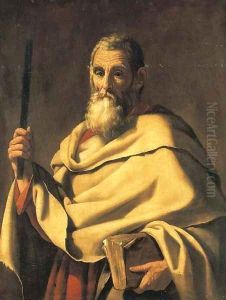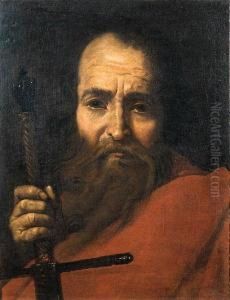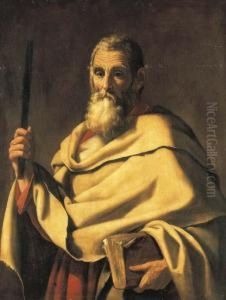Giovanni Ricca Paintings
Giovanni Ricca, also known as Giovanni Battista Ricca, was an Italian painter of the Baroque period, born in 1603 in Naples, Italy. His life and work are less documented than those of his contemporaries, making aspects of his biography obscure and sometimes conflated with those of other artists. Despite this, Ricca's contributions to the art of the 17th century, particularly within the realms of religious and historical painting, are noteworthy.
Ricca's early life was spent in Naples, a city that was a vibrant center for the arts during the 17th century, under the influence of the Spanish viceroyalty. It was in this culturally rich environment that Ricca received his initial training. While specific details about his education are scarce, it is believed that he was influenced by the works of Caravaggio, as were many Neapolitan artists of his time. This influence is evident in Ricca's use of dramatic light and shadow, a characteristic feature of the Caravaggesque style.
Throughout his career, Giovanni Ricca was known for his religious paintings, which were characterized by their emotional intensity and attention to detail. His works were primarily commissioned for churches and private patrons in Naples and the surrounding regions. Ricca's ability to convey complex biblical stories through his paintings was highly appreciated, making him a sought-after artist during his lifetime. However, unlike some of his contemporaries, Ricca did not gain significant fame outside of his native region.
Despite his relative obscurity today, Giovanni Ricca's contributions to the Baroque period remain important. His paintings are a testament to the vibrant artistic culture of 17th century Naples and provide insight into the religious and social contexts of the time. Ricca's work is preserved in various churches and collections, offering a glimpse into the world of Neapolitan Baroque art.
Giovanni Ricca died in 1656 in Naples. Although his death marked the end of an era, his art continues to be studied and appreciated by art historians and enthusiasts alike, serving as a lasting legacy of the Baroque period's rich artistic heritage. While not as widely recognized as some of his peers, Ricca's work is an integral part of the tapestry of Italian Baroque painting, reflecting the themes and stylistic tendencies of his time.


